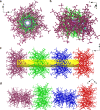A hierarchically assembled 88-nuclei silver-thiacalix[4]arene nanocluster
- PMID: 31949133
- PMCID: PMC6965622
- DOI: 10.1038/s41467-019-13682-5
A hierarchically assembled 88-nuclei silver-thiacalix[4]arene nanocluster
Abstract
Thiacalix[4]arenes as a family of promising ligands have been widely used to construct polynuclear metal clusters, but scarcely employed in silver nanoclusters. Herein, an anion-templated Ag88 nanocluster (SD/Ag88a) built from p-tert-butylthiacalix[4]arene (H4TC4A) is reported. Single-crystal X-ray diffraction reveals that C4-symmetric SD/Ag88a resembles a metal-organic super calix comprised of eight TC4A4- as walls and 88 silver atoms as base, which can be deconstructed to eight [CrO4@Ag11(TC4A)(EtS)4(OAc)] secondary building units arranged in an annulus encircling a CrO42- in the center. Local and global anion template effects from chromates are individually manifested in SD/Ag88a. The solution stability and hierarchical assembly mechanism of SD/Ag88a are studied by using electrospray mass spectrometry. The Ag88 nanocluster represents the highest nuclearity metal cluster capped by TC4A4-. This work not only exemplify the specific macrocyclic effects of TC4A4- in the construction of silver nanocluster but also realize the shape heredity of TC4A4- to overall silver super calix.
Conflict of interest statement
The authors declare no competing interests.
Figures






References
Grants and funding
LinkOut - more resources
Full Text Sources

